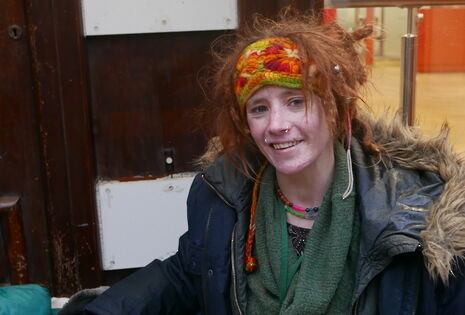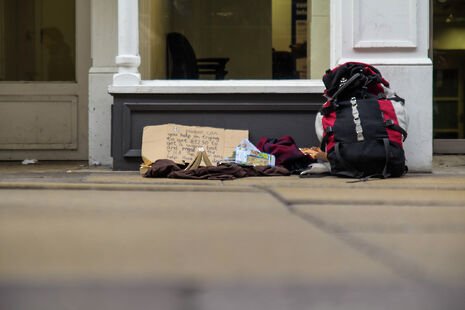The hidden reality of Cambridge’s homeless women
Every day, homeless women endure a balancing act: staying visible enough to receive aid, but hidden from predators

“I’ve been called a ‘he’ before because people are expecting to see a [homeless man].” Stella laughs. She is sitting on a pile of blue and purple blankets near Sainsbury’s on Sidney Street. She strokes the head of her dog, Girtie – who, she notes, has saved her many times – as she thinks about advice she would offer to other homeless women. “You really have to toughen up. Make yourself known to the people in outreach straight away. Sleep somewhere where you are not necessarily in the main street, but somewhere that can be seen by CCTV and might be patrolled by police. Also, get yourself a weapon in case somebody attacks you — a rape alarm, [...] or if not something to whack someone with.”
Stella’s advice reflects the balancing act women on the street endure – they must be visible enough to receive protection from outreach organisations, but they cannot be so visible that predators notice them. “I’ve been assaulted in my sleep, or I’ve had people kicking me in the head while I’ve been lying down, and there’s been somebody who was set fire to on the streets. Somebody pissed on my mate”, she says, then adds, “It’s just… why?”
The trick, she explains, is to “find somewhere that’s on camera, but it’s tucked away in a back street somewhere. Because of the CCTV, you’re being observed. You feel a bit safer then.”
Often, the specific challenges homeless women face are not visible to the public at all. Barry Griffiths, Communications, Events and Fundraising Officer at Jimmy’s homeless shelter noted, “Stereotypically, people think of [a homeless person] as a bloke.”
Stella became homeless after her partner at the time went to jail. He had abused her, and their relationship had mimicked violent patterns she had experienced with her step-father. Her story is not unusual – many homeless women have survived domestic violence from parents, partners, and other loved ones. Helen Prisley, the deputy manager at Corona House, one of Cambridge’s few women’s-only shelters, reflected on how many survivors of domestic violence she has worked with at the shelter. She said: “I wouldn’t want to put a number on it. We’ve had recent training about abuse and how many people are affected and it is... It’s huge.” Yet sometimes when survivors decide to leave violent homes, Stella added, “they’re walking straight back into the same thing on the street.”
All the while, the women may be struggling with the guilt and doubt that comes with leaving an abusive relationship. Prisley explained that some survivors of domestic violence “feel that they may never get another partner or loving relationship, so they hold onto the sort of positive moments, which are few and far between.” Although domestic abuse is a primary cause of female homelessness, Prisley mentioned that over the past couple of years she has noticed more women becoming homeless due to poor mental health or drug addictions. She commented: “There’s a real anxiety for young people to find their place, know who they are. [There’s] a pressure early on – ‘I’ve got a job, I’ve gotta do this, I’ve gotta live like this’ – and they don’t realise they actually don’t have to do this and still be okay.
“When people show up [at the shelter] you can kind of see that worry and responsibility of being an adult and what that means.”

Once on the street, the women encounter a range of difficulties. For menstrual supplies, they must rely on charity organisations or passersby, or else they “improvise,” as Griffiths put it, using cloth they find on the street. Stella remarked that “other women walking past are pretty cool. If you need something, a lot of [them] seem to, like, see, and understand, and be really kind about stuff like that because they understand, if it was [them], how difficult it would be.” She said that despite the help and the low cost of tampons, it is “really, really hard to stay clean and tidy.” As a result, Griffiths explained, some homeless women may experience toxic shock syndrome.
Both men and women who rough sleep experience sexual assault, but women are more vulnerable. “Pretty much every girl I know [has] suffered rape experiences more than once,” Stella reported, “either from other street people or from Joe Public.” Speaking to Varsity, Nora Al-Ani, director of Cambridge Rape Crisis, said that homeless women are at much greater risk of rape than other women. Sharon Pearce, a formerly homeless woman, remarked, “Whether you’re male or female, you’re all very vulnerable, very, very vulnerable. But as a woman, I suppose you’ve always got that added, you know… about being attacked.”
As these women battle their circumstances, they often have little to turn to. Stella explained that they encounter no solidarity with one another. “Women just don’t trust each other on the streets”, she said, and added: “A lot of women on the street who’ve survived have ended up becoming tomboys, and quite ‘one-of-the-lads’ because it’s safer to be that way. I think women like that see other women as a threat, maybe.” As Pearce mentioned about her experience, though she did make close friends with some of the men at Jimmy’s shelter, “There [weren’t] very many women in [Jimmy’s] when I was in, a couple came and went… I would have to say, I felt probably better with the men than I did with the women.”
Pearce also noted that the strong friendship she formed with men in the shelter, men with whom she shares “almost like an unsaid feeling of understanding,” was “unusual.” To many homeless women, the shelters can seem unsafe. Al-Ani mentioned that many women have told her that they feel “safer sleeping on the street than in a hostel situation”, where there may be dangerous men. Jimmy’s, for example, as Griffiths explained, is “not always the ideal environment for females to come into. Jimmy’s is always still heavy with the male population – probably 70% [male], 30% [female] – and it can be an intimidating environment for someone who suffered abuse at the hands of a male.” Feeling unsafe both on the streets and in shelters, often, women are stuck in limbo with nowhere to go.
Corona House, however, is an exception. The mint-green house sits on Corona Road, just past Jesus Green, and holds six self-contained flats for women at risk of being homeless. Here, women are given a space of their own, with a kitchen – complete with an oven – living room, and a separate bedroom with a single bed. They meet with key workers for one-to-one support for at least an hour every week, working on their mental health alongside employment skills.
From the moment one steps into the house, the role of art in the community is clear. Paintings made by residents over the years in bright, vivid hues of red, yellow and blue, line the walls. One room, the crafts room, has a slanted ceiling and sunlight pouring in from its large windows onto a red sofa and rug. Speaking to Varsity, one resident, who wished to remain anonymous, remarked on the safety and comfort of the shelter. She said: “It’s a safe place where it’s [okay] to have bad days and to lack skills, and to know I can find my feet again with Corona.”
The shelter received 22 applications in 2015, 17 in 2016, and 29 in 2017. As one of only a number of women’s-only shelters in Cambridge, however, its six flats have proved insufficient to cope with the scope of women’s homelessness in the city. Prisley emphasised that the shelter itself could not be expanded without compromising on quality. The solution she is hoping for, instead, is for another women’s shelter to be set up.
The landscape of women’s homelessness, however, is broader still. Though women encounter a particular set of challenges when they are homeless, both Pearce and Stella pointed out that people of all genders endure other hardships on the street that can be similar. Pearce said: “It can happen to anybody… Things happen in life. It’s very important to realise that they’re just down on their luck.”
- This article was updated to make clear that the weapon referenced in the first paragraph was solely for purposes of defence.
 Comment / Plastic pubs: the problem with Cambridge alehouses 5 January 2026
Comment / Plastic pubs: the problem with Cambridge alehouses 5 January 2026 News / Cambridge businesses concerned infrastructure delays will hurt growth5 January 2026
News / Cambridge businesses concerned infrastructure delays will hurt growth5 January 2026 News / New movement ‘Cambridge is Chopped’ launched to fight against hate crime7 January 2026
News / New movement ‘Cambridge is Chopped’ launched to fight against hate crime7 January 2026 News / Uni-linked firms rank among Cambridgeshire’s largest7 January 2026
News / Uni-linked firms rank among Cambridgeshire’s largest7 January 2026 News / AstraZeneca sues for £32 million over faulty construction at Cambridge Campus31 December 2025
News / AstraZeneca sues for £32 million over faulty construction at Cambridge Campus31 December 2025









